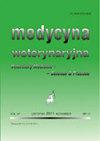Microbiological status of smoked fish placed on the market in Poland
IF 0.4
4区 农林科学
Q4 VETERINARY SCIENCES
Medycyna Weterynaryjna-Veterinary Medicine-Science and Practice
Pub Date : 2023-01-01
DOI:10.21521/mw.6823
引用次数: 0
Abstract
Fish and fishery products are considered to be one of the most nutrient-rich dietary products. The nutritional value of fish depends on its freshness. The greatest role in fish spoilage is played by microbial decomposition. Smoking is one of the methods of fish preservation based on the action of temperature and the penetration into the tissue of preservative substances produced by burning wood. Almost all microorganisms except some pathogenic bacteria are destroyed in the smoking process; nevertheless, fish can be a source of some pathogenic microorganisms, i.e. Listeria monocytogenes, Salmonella spp., Staphylococcus spp., which are present as the result of cross-contamination at the stage after smoking, i.e. marketing and storage (4, 5, 8). Improper and unhygienic handling practices with the ready-to-eat RTE product are also the cause of an increase of the total microbiological contamination, which can be expressed by microbiological contamination indicators, i.e. total viable count (TVC), psychrophilic bacteria count (PBC), coliform count (EBC), total yeast and mould count (TYMC) and total staphylococci count (TSC). In the performed study five smoked fish species (redfish, mackerel, codfish, sprat and herring) were tested at the marketing stage. A total number of 50 (N = 50) samples was tested according to ISO standards. The potential foodborne bacteria in the tested samples were identified using a MALDI-TOF spectrometer combined with MALDI-Biotyper 3.0 software. In the performed study, the highest microbiology contamination TVC on the level 3.63 ± 0.15 log10 cfu/g and PBC on the level 3.04 ± 0.24 log10 cfu/g has been found in redfish muscle compared to herring, codfish, sprat and mackerel muscle. A significantly lower amount of 1.26 ± 0.12 log10 cfu/g yeast and moulds of was found in the muscle tissue of herring, compared to the other tested fish. The highest staphylococcal contamination of muscle tissue of redfish on the level 2.56 ± 0.15 log10 cfu/g and mackerel on the level 2.13 ± 0.15 log10 cfu/g was found. MALDI-TOF identification of isolated bacteria not confirmed the presence of Salmonella spp., Listeria monocytogenes and pathogenic Staphylococci and confirmed the presence of E. coli in tested redfish.波兰市场上熏鱼的微生物状况
鱼和渔业产品被认为是营养最丰富的膳食产品之一。鱼的营养价值取决于它的新鲜度。微生物分解在鱼类腐败中起着最大的作用。烟熏是一种基于温度作用和木材燃烧产生的防腐物质渗入组织的鱼类保鲜方法。除一些致病菌外,几乎所有的微生物都在烟熏过程中被消灭;然而,鱼类可能是一些致病微生物的来源,如单核增生李斯特菌、沙门氏菌、葡萄球菌,这些微生物是在熏制后的阶段,即销售和储存阶段交叉污染的结果(4,5,8)。即食即食即食产品处理不当和不卫生的做法也是微生物污染总量增加的原因,微生物污染总量可以用微生物污染指标来表示。即总活菌数(TVC)、嗜冷细菌数(PBC)、大肠菌群数(EBC)、酵母和霉菌总数(TYMC)和葡萄球菌总数(TSC)。在进行的研究中,在销售阶段对五种熏鱼(红鱼、鲭鱼、鳕鱼、鲽鱼和鲱鱼)进行了测试。按ISO标准共检测50个样品(N = 50)。采用MALDI-TOF光谱仪结合MALDI-Biotyper 3.0软件对检测样品中的潜在食源性细菌进行鉴定。在本研究中,红鱼肌肉的微生物污染TVC和PBC分别为3.63±0.15 log10 cfu/g和3.04±0.24 log10 cfu/g,高于鲱鱼、鳕鱼、鲽和鲭鱼肌肉。鲱鱼肌肉组织中酵母和霉菌的含量(1.26±0.12 log10 cfu/g)显著低于其他受试鱼类。红鱼肌肉组织中葡萄球菌污染最高,为2.56±0.15 log10 cfu/g,鲐鱼肌肉组织中葡萄球菌污染最高,为2.13±0.15 log10 cfu/g。MALDI-TOF对分离细菌的鉴定未证实存在沙门氏菌、单核增生李斯特菌和致病性葡萄球菌,并证实在受试红鱼中存在大肠杆菌。
本文章由计算机程序翻译,如有差异,请以英文原文为准。
求助全文
约1分钟内获得全文
求助全文
来源期刊

Medycyna Weterynaryjna-Veterinary Medicine-Science and Practice
VETERINARY SCIENCES-
CiteScore
0.80
自引率
0.00%
发文量
73
审稿时长
4-8 weeks
期刊介绍:
"Medycyna Weterynaryjna" publishes various types of articles which are grouped in the following editorial categories: reviews, original studies, scientific and professional problems, the history of veterinary medicine, posthumous memoirs, as well as chronicles that briefly relate scientific advances and developments in the veterinary profession and medicine. The most important are the first two categories, which are published with short summaries in English. Moreover, from 2001 the editors of "Medycyna Weterynaryjna", bearing in mind market demands, has also started publishing entire works in English. Since 2008 the periodical has appeared in an electronic version. The following are available in this version: summaries of studies published from 1999 to 2005, full versions of all the studies published in the years 2006-2011 (in pdf files), and full versions of the English studies published in the current year (pdf). Only summaries of the remaining studies from the current year are available. In accordance with the principles accepted by the editors, the full versions of these texts will not be made available until next year.
All articles are evaluated twice by leading Polish scientists and professionals before they are considered for publication. For years now "Medycyna Weterynaryjna" has maintained a high standard thanks to this system. The review articles are actually succinct monographs dealing with specific scientific and professional problems that are based on the most recent findings. Original works have a particular value, since they present research carried out in Polish and international scientific centers.
 求助内容:
求助内容: 应助结果提醒方式:
应助结果提醒方式:


